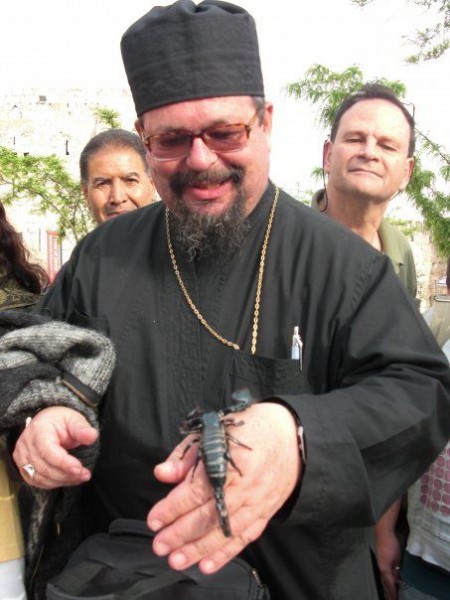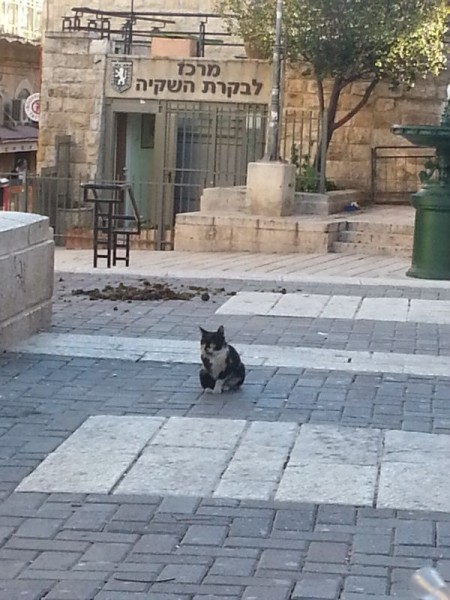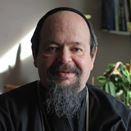The New Edicule In Jerusalem : The Liturgical Hour at the Anastasis
This Wednesday morning, 22nd of March 2017, a most unexpected event took place in the Old City of Jerusalem. After months of work, repair, digging activities inside of the Church of the Holy Sepulcher that had started in April 2016, the renovated Edicule or Tomb (considered as such according to most of the local Churches) was inaugurated in the presence of the Heads of the local Church of Jerusalem and many civil and religious representatives.Responding to the requirement of the Israeli authorities that observed the dangerous stand of the little building structure located over the supposed tomb of Jesus of Nazareth, the Greek Orthodox Patriarchate of Jerusalem took the lead of the restoration of the site by signing an agreement with the other Churches who are in charge of taking care and managing the space of the Holy Sepulcher compound, i.e. the Franciscan Custody of the Holy Land on behalf of the Catholic Church of Rome and the Armenian apostolic Patriarchate of Jerusalem. This place this is considered as « undisputed » by the traditional Orthodox and Catholic, Anglican, ancient Orthodox (Armenian, Coptic, Syrian-Orthodox bodies) though criticized by some of the Protestant movements).
The restoration started in April 2016 and totally restructured the « Kouvouklio or Edicule » built from ancient times on the said location of the grave of Jesus of Nazareth. The Gospel account how he was buried « outside of the City (of Jerusalem at his time) » in a garden where the outlaws used to be crucified. This means that the place was known to be empty.
The tradition was passed generations by generations of faithful and pilgrims who came to the holy sites of the nascent Christian Church until Helena, the mother of Emperor Constantin,decided to explore the location and found the « true Cross ». She left the place of the tomb uncovered. Eusebius of Caesarea mentioned that the site was surrounded by pillars but the rock was open. The renown pilgrim Etheria ascertained that there was an enclosed edifice that protected the rock.
The Church has been destroyed several times throughout the centuries. The faithful always continued to visit the holy place. After the destruction of the Church by Al Hakim (1009-1012 CE) the rock was leveled and the framed edifice was totally destroyed. Following the restoration of the Church by Constantinos VIIII Monomahos (1042-1048 AD) a new edifice has been constructed, a sort of large mausoleum in the middle of pillars. The structure was destroyed and rebuilt many times and took it final shape by 1555 when the Franciscans restructured the shrine, extending it to the « chapel of the Angel » located at the entrance of the site. In 1808, a great fire burnt the whole place.
The Edicule took its present form in 1810 as an engraved inscription on the façade states:
« The Edicule of the Holy Sepulcher was reconstructed completely from its foundations by the charity of the Orthodox Romans (Byzantine Greeks) when Polykarpos was patriarch in the year 1810 and the month of March. »
In fact, each Church body has been involved in the management and protection of their « own divisions » inside of the Holy Sepulcher or within its compound. The « Status Quo » or internal rules governing the control of each part of the Holy Site was imposed by the Sultan in 1853. It remains in force at the present and has been respected by the time of the British Mandate, the Jordanian rule and, at the present, the Israeli supervision after the Six-day War, i.e. in 1967, fifty years ago this year.
The last common work that has been achieved as the consequence of an agreement passed between the major Churches, consisted in the repair of the dome over the Edicule in the years 1994 to 1997. In 2000, the Churches also had to work together as crowds were heading to the Holy Sites for the two thousands year since the birth of Jesus of Nazareth. The next great event to come should happen in 2033 for the inter-denominational accepted date of the resurrection of Jesus.
Different reports were made, especially while the first surveys and digging out of the rock down to the supposed place where the Jesus the Jew had been buried. Very emotional moments for all the leaders of the local Churches though the visits were quite limited. As Antonia Moropoulou of the National Technical University of Athens, in charge of the whole restoration of the Edicule, declared: « Different level of history have been scanned and validated ».
Thus, today, on March 22, 2017, on the Name Day of the Greek Orthodox Patriarch Theophilos of Jerusalem, the new Edicule has been opened. This is a turn. Patriarch Theophilos said in English how the process could be launched with the moral and financial support of many supporters, benefactors. He mentioned King Abdullah II of Jordan, the Palestinian authority, the Greek and Russian donors and the exceptional goodwill that allowed the team led by Mrs. Antonia Moropoulou to convey a huge work of repair, achieved with a common sense of unity.
Following the speech of Friar Francesco Patton, the new Custos of the Franciscan Custody, the Armenian Patriarch Nouhran of Jerusalem also delivered a speech in English, pointing out the common goodwill of the civil and religious bodies in charge of the renovation. He added that this should open to new times. He is one of the representatives of pre-Chalcedonian Churches (along with the Syrian-Orthodox, the Coptic and Ethiopian Churches), he suggested that, on the first Sunday following Easter, the Coptic and Ethiopian communities as well as the Anglican Church could be allowed to serve the Divine Liturgy inside of the newly rebuilt Edicule, i.e. the place revered by all the Christians as the source of the faith in the resurrection.
This can also be a major turn. It requires the agreement of all the heads of the local Churches. It is quite possible that the proposition can be adopted after a while of reflection because of the exceptional newness of the restoration of the shrine.
Archbishop Pierbattista (Pizzaballa), Apostolic Administrator of the Latin Patriarchate was the Custos (guardian, leader) of the Custody of the Franciscans in the Holy Land when the different Churches reached an agreement to carry out the reconstruction of the Edicule. He underscored how this task had been considered as totally improbable, impossible by most of the native local Christians of Jerusalem and the Holy Land as also the pilgrims and visitors. He stated that this new situation should be extended to other actions of solidarity.
The special guest was today Bartholomaios, Archbishop of Constantinople and Ecumenical Patriarch who spoke in Greek. He is the Primus inter pares (the first among the equals) of the Orthodox Churches. He had come last to Jerusalem and the Holy Sepulcher in 2014 where he had met Pope Francis of Rome for the commemoration of the fiftieth anniversary of the historic encounter of Pope Paul VI with Patriarch Athenagoras of Constantinople, hosted by the then-Patriarch Benediktos of Jerusalem as Theophilos was his deacon.
Some people may have been surprised to hear His Holiness Bartholomaios deliver his speech in Greek without any translation into English.
There maybe different explanations for this and one should consider his choice with regards to specific reasons. Is it a national or even « para-nationalist » move? Many will think it was. The language was neutralizing the cultural differences, especially towards the Arabs and the Slavs. But Greek is both from the nearby ancient cultural areas that speak the original language of the prestigious language shared by the Antiquity, the philosophers and the first version of the Gospel. Greek is also the language of the Septuagint (translation realized by the 70 Jewish translators of Alexandria from the Hebrew Texts) and is the official Bible version recognized by the Orthodox Church. Greek is also « local » as the language has been spoken from most ancient days (Alexander the Great) and, curiously, is shows some similarities with Hebrew in modern times since it has remained a living, an old and new language. He was the only hierarch to mention the State of Israel with gratitude.
It also underlined the Greek Orthodox responsibility as having survived over the centuries beyond the numerous tragedies that affected the Christian history of the Holy Sites. Maybe this was also, by ricochet, a call to pay attention to the presence of the Greek Prime Minister, Alexis Tsipras, the leader of the European country located at the border between Europe and Near-East – as Cyprus also is historically – that faces the hardship of terrible impoverishment and the arrival of the crowds of refugees.
Finally, Archbishop Giuseppe Lazzarotto Catholic Apostolic Delegate in Jerusalem and Palestine and Apostolic Nuncio in Israel spoke in English. He read the cheerful message of Pope Francis… Some people expected the presence of a special envoy, but the nuncio is the right man in the right place for the right event where the atmosphere is always special and « bon enfant », with a touch of provincial taste.
Among the visitors there were some Russian Orthodox bishops, in particular Metropolitan Onufryi of Kiev and All Ukraine accompanied by two hierarchs and the members of the Russian Ecclesiastical Mission in Jerusalem (Patriarchate of Moscow), the delegate of the Romanian Church in Jerusalem, Fr. Timofii, and some visitors from former Yugoslavia as Athanase (Jevtić), Bishop emeritus of Zachumlie and Herzegovina, a renown Orthodox theologian and Bible translator.
Patriarch Bartholomaios stressed one aspect that is typically Eastern Orthodox: he declared that « this inauguration is a liturgical hour« . This is the way the original CHurch of Jerusalem sees the newness of reconstruction. The edicule is rebuilt but the Tomb is and remains, will remain empty. Thus, Liturgy corresponds to the very « work of the consecrated people (ergon tou laou) » who continue their journey through the invisible sign of the resurrection.
This is also parallel to the Jewish blessing that the Father of all beings maintains all in life till this day and this period of history.
Link to the Jerusalem Patriarchate (Greek Orthodox) TV site: « https://youtu.be/PC_1n3DoLzc » (the inauguration).
Link to the Christian Media Center: « https://youtu.be/UL-DR5NRiSE ».





 Av Aleksandr Winogradsky Frenkel
Av Aleksandr Winogradsky Frenkel








